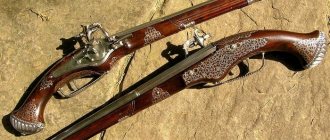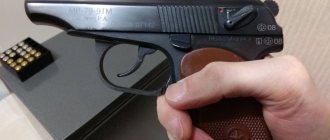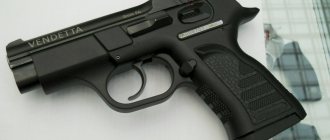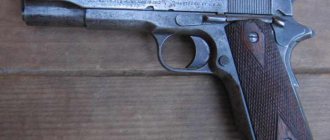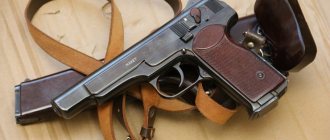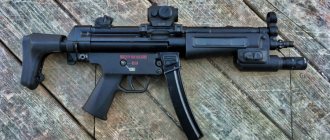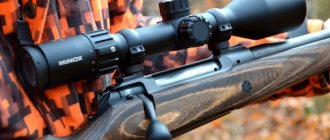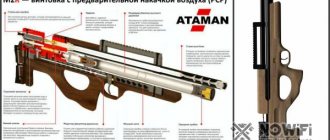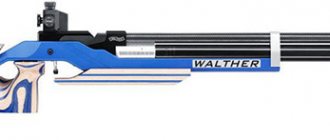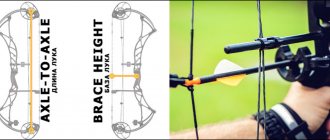A hot presentation of the new 2022 pistol is coming; advancing and pushing into the spotlight after a record year in firearms sales. Much of the industry is trying to catch its breath as gun buyers continue to rummage through empty storefronts, ready to pounce on the hint of a restocking. Currently, most manufacturers are struggling to keep up with current demand and are focusing on producing obsolete products to fill back orders, much to the chagrin of their marketing departments. This means that several well-known brands are missing from the list at the time of publication. Don't worry - they're coming - they'll only be a month late to the party. We will continue to provide updates after the embargo expires. Without further ado, we've compiled a list of the best new pistols released in 2022.
History of creation
| date | Event |
| 1836 | Presentation by design engineer S. Colt of the first revolver, called “Paterson” |
| 1840 | Mass production of revolvers of various modifications |
| 1847 | Serial production of the new Colt Walker revolver and development of new models |
| 1952 – 1953 | Manufacturing of a pin chuck and a revolver with the Lefoshe system |
| 1857 | Work on the creation and manufacture of the Smith and Wesson brothers revolver |
| 1878 | Patenting of a new Nagan system revolver and mass production |
| 1892 | Release of an improved revolver model with the Nagan system |
| 1895 | Production of the first revolver with the Nagan trigger mechanism and subsequent serial production |
The creation of the capsule mechanism was one of the most important achievements of the 19th century, which gave a great impetus to the development of firearms.
In 1835, the first revolver was designed, which was superior in all qualities to all previous types of firearms. The capsule system allowed the weapon to be used in wet weather and minimized the occurrence of misfires.
Colt Paterson 1836
In 1836, engineer S. Colt presented the first successful example of the Paterson revolver with drum-fed cartridges. The reloading process has become easier due to the built-in lever for pressing the bullets into the drum, which made it possible to conduct high-speed shooting with minimal time required to reload a full drum.
Colt revolver rifles
Revolving rifle From 1847 to 1851, S. Colt launched mass production of several models of Walker and Navi revolvers, which were made on the Paterson basis with minor modifications and improved characteristics.
The pin mechanism of the Lefoshe revolver
In 1852, the French design engineer Lefoshe developed a new type of cartridge, which was called a hairpin cartridge. The cartridge had a copper sleeve with a small primer and pin. This type of cartridge made it possible to achieve increased lethal characteristics and a more advanced design. A year later, the first hairpin revolver was released with a corresponding system in which the firing pin hit the hairpin, and that struck the cap.
In 1878, the Belgian engineer E. Nagan created the first successful models of revolvers with unitary cartridges. The cartridges had a primer at the bottom of the case, filled with black powder, which is an example of a modern cartridge. In the same year, mass production and export were established.
Revolver Nagan 1878
In 1892, after the first successful model, E. Nagan continued to work on creating new cartridges and revolvers, which led to the appearance of a new revolver model using a more improved mechanism and new cartridges with smokeless powder.
In 1895, a revolver was made that used a self-cocking trigger mechanism, which made E. Nagan famous throughout the world and was used in many armies and wars.
The first revolvers:
| Year | Name | Characteristics |
| American revolver 1851 | Cowboy Colt |
|
| 1853 | Leshofe |
|
| 1869 | Smith and Wesson |
|
| 1882 | Wobel Green |
|
| 1895 | Revolver |
|
Springfield Armory Ronin 10mm
Springfield Armory seems to be showing off the 10mm band, hitting home runs with every new introduction, and the new Ronin 10mm is sure to be another winner. A 1911 that won't break the bank, the Ronin is for you. This powerplant uses a rugged forged stainless steel frame mated to a forged carbon steel slide for extreme weather resistance and durability in the field. The 5-inch barrel is forged for long-lasting strength, durability and sharp loads. The magazine capacity is 8 + 1 10 mm cartridges in one magazine. The Ronin is a 40-ounce unloaded heavyweight, but is designed to last a lifetime when fully fired. - power loads on dangerous targets with minimal muzzle rise. This allows your scope to hit and stay on target during fast multi-shot strings. MSRP: $850;
A strange victory in a strange competition
Stop, I’ll shoot: rating of the best traumatic pistols for 2020
In short, there didn’t seem to be very many chances that the strange Nagan system would end up in service in the Russian army. However, Leon was not embarrassed, he came to Russia, demonstrated the product - and then a rather murky story begins. There is no direct evidence of corruption of military officials, but several interesting points have been added to the technical requirements for the new weapon.
So, the revolver, it turns out, must be non-self-cocking (we remember that the accuracy of the “revolver” was not very accurate when shooting self-cocking). They were motivated by the fact that it was not good for a Russian soldier to waste a lot of ammunition; it was better to aim more carefully. The extraction of cartridges from weapons was now required one at a time, and not simultaneous (this statement generally lends itself poorly to logic). The drum capacity is seven rounds, and not one less (there are a huge number of excellent six-round systems in the world; the presence of seven rounds is not critical for anyone).
Photo: wikipedia.org
When reading these valuable instructions, one gets a slight feeling that in this case they were not so much looking for a weapon to meet the requirements, but rather adjusting the requirements to the only correct weapon. But while no unambiguous evidence of unscrupulousness of the admissions committee has been found, we will assume that all this is an accident. It just happened so well that it doesn’t happen to anyone.
So, Leon Nagan converted his revolver to a Russian cartridge and submitted it to a competition announced by the Russian military department. The competition began in 1893 and turned out to be quite strange. Most of the models presented did not pretend to be miracles of weapons design.
So, Sergei Mosin sent a certain “six-barreled revolver” to the competition. Not a single image of the Mosin model survives, but at the end of the 19th century, the weapon with six barrels was either a Gatling gun or a blast from the past - an impossible anachronism. A couple more options (the Kuhn-Zalubovsky and Winen models) were attempts to remake the good old Smith and Wesson, and there were also a couple of extremely imperfect automatic pistols.
A real fight was possible only between the Nagant and Pieper models. The latter presented a seven-round revolver with a side-folding cylinder and simultaneous extraction of cartridges - in a word, a standard modern representative of its class.
However, in terms of the totality of its qualities, the Pieper system was inferior to its competitor, and the slightly modified revolver triumphantly won and entered service in 1893. And Leon Nagant again received a round sum of money from the Russian Treasury.
Types of revolvers by design
Top 10 best submachine guns in the world
According to their design, pneumatic revolvers are divided into weapons with a rifled and smooth barrel. The first type has a clockwise spiral rifling that twists the bullet. Thanks to rotation, it stabilizes in the vertical plane, which increases the accuracy and accuracy of fire.
Almost all air pistols and revolvers have a principle of operation based on the ability of gas to quickly expand. After installing the cylinder and preparing the weapon for firing, carbon dioxide partially fills a special expansion chamber with a dispenser valve.
At the moment of firing, the valve opens and releases carbon dioxide, which, constantly expanding, pushes the projectile forward and gives it initial acceleration. If false cartridges are used as bullets, then the gas enters directly into the cavity of the cartridge.
KelTec P50
Known for its unorthodox design and expanding store capabilities, KelTec doesn't disappoint with its all-new P50. KelTec calls it unique, adaptable and retro. I think it's a cross between a space gun and a bullet hose. Either way, the pistol fires 5.7x28mm rounds with high velocity and low recoil, which it draws from a 50-round magazine. Yes, that's right, 50 points. And there are two of them in the set. I bet this is one heck of a fun gun to shoot with or as a trusty companion when you're trekking through prairie dog country. Retail price is $1000 if you can find it. www.keltecweapons.com
List of revolvers by country of manufacture
| Rating of the best traumatic pistols: which traumatic pistol is better to choose Name | Manufacturer, Year | Caliber | A country |
| Beretta Laramie | Beretta, 1980 | .45LC .38Sp | Italy |
| Beretta Stampede | Beretta, 1990 | .45LC .357Mag | Italy |
| Astra 680 | Astra-Unceta y Cia SA, 1981 | .22LR .32S&W .38Sp | Spain |
| Colt M1917 | Colt's Manufacturing Company, 1917 | .45ACP | USA |
| Colt Detective Special | Colt's Manufacturing Company, 1927 | .32NP .38NP .38Sp | USA |
| Colt Python | Colt's Manufacturing Company, 1953 | .357Mag | USA |
| Enfield | RSAF, 1879 | .476 | Great Britain |
| Korth Combat | Korth, 1967 | .357Mag .38Sp | Germany |
| Manurhin MR 73 | Manurhin, 1970 | .22LR .32S&W Long .357Mag | France |
| New Nambu M60 | Shin Chuo Kogyo KK, 1960 | .38Sp | Japan |
| Remington Model 1858 | Remington Arms, 1858 | .32 | USA |
| Smith & Wesson Model 686 | Smith & Wesson, 1980 | .357Mag .38Sp | USA |
| Taurus Raging Bull | Taurus International, 1995 | .454Cas | Brazil |
Video detailing what a revolver is
https://youtube.com/watch?v=s7y6KfQtcGo
Operating principle
To load the revolver, it is necessary to place the trigger in a special safety position so that the drum does not have the opportunity to rotate. While rotating the drum, you need to put on the capsules one by one. On the inside of the original drum, cartridges are inserted into special sockets. Unique cartridges are made from a special cartridge case containing the necessary charge and a heavy lead bullet. The original cartridge in a special drum socket is sealed with a special cleaning rod.
To fire a shot you need to cock the trigger. When the hammer is cocked, the revolver cylinder rotates, placing the next chamber against the barrel, which is fixed in this position. Simultaneously with the rotation of the drum, a folding trigger extends onto one camera.
FN 509 LS Edge Tactical
FN has been in the pistol game for some time now and they have had success with the 509 series pistols. The 509 was designed for the US Army's modular pistol system and contains the DNA to compete at a high level in today's crowded field. This pistol features the FN Low Profile Optics Mount System, a plate adapter design that facilitates the direct mounting of over 10 optical sights, all of which are compatible with FN suppressor sights, including the Leupold Delta Point Pro. It's no exaggeration to say that the FN optical system is probably the best wafer system in the business. The 509 LS Edge Tactical is a factory hot rod competition pistol featuring a 5" bullseye barrel, cold hammer forged barrel, lightweight flat face trigger, sliding zippers, oversized controls and a substantially expanded magazine to accommodate up to 24 rounds. - round magazine. If you're looking for a turnkey kit or a nightstand to be reckoned with, the 509 LS Edge Tactical is your blueberry. MSRP: $1,500; www.fnamerica.com
Top 10 Smallest Pistols
“Do you have a gun in your pocket, or are you just glad to see me?” The famous phrase of Mae West has by now slightly lost its relevance: today there are a number of models that differ in downright microscopic sizes. We bring to your attention the top 10 smallest pistols, but still very dangerous firearms “toys”. By the way, Dekatop previously published the Top 10 Best Pistols. 1 Taurus Curve
Length – 128 mm; height – 95 mm, thickness – 22 mm. The product of the American company Taurus weighs only 400 grams, but this is not its main advantage. Its body is made of special polymers and therefore has no sharp corners. A deadly toy with a smooth, streamlined shape can easily be carried in your pocket without attracting everyone's attention. However, it also has disadvantages: the pistol does not have a safety lock or a trigger delay lever.
2 NAA Guardian 380 from Colt
Used by American police as a backup weapon. It is highly valued precisely because of its miniature size and low weight - just over 600 grams. Convenient, reliable, lightweight, it has many modifications and configurations, and it costs relatively little - about $400.
3 DoubleTap
The titanium pistol from Heizer Defense boasts a weight of 400 grams and rather modest parameters: a length of 126 millimeters and a height of 100. Double-sided compensators ensure minimal barrel bounce when fired, and high-strength material minimizes the risk of corrosion.
4 OTs-21 “Baby”
Yes, yes, you and I have something to be proud of: a small-sized self-loading pistol made in Russia takes pride of place in our rating. However, according to experts, the quality of the weapon leaves much to be desired: the magazine is designed to hold only five rounds, and the shooting accuracy is not very high.5 SIG-Sauer P290
Not very convenient, but quite functional and miniature firearm from Parabellum. Length 140 millimeters, magazine for 6 - 8 rounds, the ability to additionally order a laser target setter - as they say, the company doesn’t knit brooms.
6 Seecamp LWS 32 Auto
Seacamp's most popular product. It looks extremely harmless: this little pistol fits easily in the palm of your hand. But appearances, as often happens, are deceiving: such a little thing can easily take a person’s life. It is the second modification of three: the first - LWS 25 - was produced from 1981 to 1985, the third - LWS 380 - was presented in 1999, but did not gain wide popularity.
7 Derringer DA 38
A very beautiful mini-pistol with a bullet caliber of only 9 millimeters. Nevertheless, his return is to be healthy. An untrained person, shooting from such a “barrel”, can easily dislocate his shoulder.
8 P08 Luger
Let's look back: at the beginning of the 20th century, people also loved and valued miniature weapons. A clear confirmation of this is this model: an elegant parabellum with an anatomical handle inclined at a large angle. The miniature modification from 1908 deserves special mention – it took more than 600 hours to create.
9 Franz Pfannl Erika 1912
We continue the historical theme: the next exhibit has a caliber of 4.25 millimeters and is loaded with 5 rounds. Developed in 1912 by German gunsmith Franz Pfannl. According to unverified information, there are about 3,500 such pistols in the world, which makes them a real hunting item for collectors.
10 SwissMiniGun
5.5 centimeters in length, 2.34 mm caliber bullets... It sounds funny, and the revolver looks more like a keychain than a firearm. But he hits without missing a beat: the shot range is 112 meters. The model has several collectible pieces made of pure gold and encrusted with diamonds. So the image of a cool hero with a .39 caliber Magnum is becoming a thing of the past - in fact, it is only good for cinema, but in life it is much more convenient to use such a “toy”...
The revolver that no one liked
The army accepted the new product without enthusiasm. On the one hand, carrying a light revolver with you was much more pleasant than a heavy Smith & Wesson. On the other hand, in enlightened times, having a revolver that could not fire by self-cocking was somehow undignified. In war, everything can be decided in a split second, and there may simply not be time to cock the gun. As a result, the revolvers were made self-cocking. But not all of them, only officers: soldiers, from the point of view of their superiors, can handle it anyway, otherwise they don’t have endless cartridges.
The correction did not in any way eliminate the problem of long reloading - so the Russian military stubbornly refused to consider the new product good. At its core, the revolver was a structurally outdated model, even compared to earlier revolvers, such as the English Webley. And just a year after its adoption, the legendary Mauser S-96 appeared, then the Borchardt pistol, the new Smith & Wesson, the great inventions of John Browning - a new era was dawning in which the Nagant system looked like a Neanderthal.
It would seem that everything is clear, it’s time to rearm again. But sending weapons that were barely accepted for scrap - no, the officials could not admit that they had made a big mistake. And the treasury was chronically short of funds, especially after the disastrous Russo-Japanese War.
Instead of rearmament, the military department decided to allow officers who do not like their native revolver to buy pistols or revolvers of foreign models at their own expense - as well as cartridges for them.
Russian army officers did not shine with special wealth. Nevertheless, “voting with rubles” turned out to be widespread - in which case life is more expensive. Therefore, excellent evidence soon appeared like “Artcom especially emphasized that competitive shooting was allowed only from a Nagan system revolver, not from “Parabellums and Brownings,” as the officers sought to do.”
American Ruger Competition
Ruger also tests the waters with the factory pistol for competition with American competition. Based on the popular American pistol, this option boasts a 5-inch stainless steel sporting barrel with a 1:16-inch slow twist for improved accuracy with lighter match rounds. The slide has eight holes cut into the front of the slide, while the rear is drilled and tapped to directly mount multiple miniature red dot sights that share the same Doctor Optic mark. These include Venom Vortex, Burris FastFire, and several other inexpensive brands. Everything else is purely American, and that's good. If you're thinking about competing in USPSA, IPSC, or IDPA matches but don't want to break the bank, the American Competition pistol may be a better option, especially with an MSRP of just $580. www.ruger.com
Manager Colt
For all its advantages, consumers identified some shortcomings in the “Paterson” (that was the name of the first model; it is also often called “Texas”). Buyers liked the price of $20, but army officials did not like the high consumption of charges. No one bothered to explain that the reason was not the rate of fire of the model (this was always considered an advantage), but the personal qualities of the owner of the weapon. There were other claims that led to a decline in demand for Colt's revolver, and eventually, by 1842, demand had fallen so low that the company had to close due to bankruptcy. But the talented engineer was not going to give up. Realizing that technical knowledge alone was not enough, he took up the economic aspects of business. In particular, the revival of the company in 1847 was facilitated by the expansion of the model range
Attention was also paid to advertising, including hidden advertising, which today is called “plywood”. Every writer or artist who introduced a Colt revolver into the plot of his work was rewarded, and not just in words
CZ P-10S in FDE and OD
The striker-fired CZ P-10C was an immediate hit when it hit the market a few years ago. CZ purists have even embraced the polymer frame striker pistol, which is certainly saying something since they are a vocal group. Since its launch, the P-10 range has grown from a versatile mid-size C model to full-size and long slide options. For 2022, CZ is moving in the opposite direction and has released a subcompact it calls the P-10S. Not only are the frame and slide shrunk to the size of a noisy cricket, but the S also features a deep optical cut and a modular plate mounting system that's sure to be compatible with your favorite mini red dot scope. A small concealable pistol with a red dot and a nice trigger? Yes please. But that's not all - the P-10S also received a new paint job. Flat Dark Earth and Olive Drab are added to the flavor if black isn't your thing. Get yours for about $630. For more information visit www.cz-usa.com
[edit] Construction
Frame
The revolver frame can be:
- unclosed - open at the top, like on capsule Colts. It is technologically simple, but not tough enough. Not used since the 70s. XIX century;
- unlockable - part of the frame, together with the barrel and drum, is hinged. This scheme simplifies reloading, but is very sensitive to the condition of the hinge and frame lock. It was common in the second half of the 19th century, especially on Smith and Wesson revolvers:
- solid - such a frame is rigid and allows the use of cartridges of any power. The vast majority of modern revolvers have a solid frame.
Drum
The drum is the magazine for all revolvers. Some ancient models had radial cartridges, but most ancient and all modern revolvers have a cylinder with parallel cartridges. The number of cartridges in the drum is from 5 to 8, but there are single revolvers that contain up to 30 cartridges.
"Kedr PP-91"/"Klin PP-9"
The submachine gun is characterized by the following features:
- caliber - 9 millimeters;
- rate of fire - up to 1200 rounds per minute;
- magazine - 20-30 rounds;
- Firing range - up to 100 meters.
The submachine gun appeared in the early 1990s and is used by Russian internal troops. The Klin PP-9 model is an improved version of the Kedr PP-91, designed for more powerful cartridges.
Both weapons have a similar design with blowback-based automatic action. These models provide a trigger mechanism. The submachine gun supports single-round firing modes. It is also possible to equip it with a silencer and an optical sight.
Revolvers
A “real” revolver is a firearm for close combat, the mechanism for feeding cartridges is made in the form of a cylindrical rotating magazine - a drum, where chambers with cartridges are located.
- Instant first shot - no need to remove the safety like a pistol or perform any other manipulations before firing. This design feature has saved the lives of more than one person.
- Durability - reloading occurs due to the muscular strength of the shooter, and not under the influence of inertial forces or powder gases, as a result, the main elements practically do not experience the destructive effects of the shot.
- Reliability – in case of a misfire, you just need to press the trigger again. Moreover, due to the absence of springs in the design, the revolver is ready to fire even after long-term storage, when, as in pistols and rifles, during this time the springs weaken and make the weapon ineffective.
All these features were adopted by the compressed gas revolver. The pneumatic version differs from its counterpart only in the principle of operation, power and type of cartridges.
Taurus TX22 Competition
The TX22 is a purpose-built .22LR semi-auto, rather than a smaller, corner-cut version of the centerfire variant. Because of this, the TX22 was an immediate success as soon as it was released, thanks to its increased magazine capacity (16 rounds), real mid-size pistol ergonomics, and reliable performance. We liked the original, but that's because we didn't know there was a competition version coming soon. Now that it's here, all we can say is wow. The TX22 is competition-ready right out of the box with a 5-inch threaded barrel and a unique, adaptable optics mounting solution. The optic mounts to the barrel hood using a sliding plate system that is compatible with most popular miniature red dot sights. But that is not all; The mounted optic does not reciprocate with the slide, making it much faster and easier to track points as it remains stationary. This equates to lightning fast transitions from target to target, and the point stability is insane. We hope this technology finds its way into future centerfire pistols. This mounting method is what the future of pistol optics looks like, and Taurus is bringing its game to the table. MSRP: $405; www.taurusx22.com
“Good toy” - Umarex Smith & Wesson Military & Police R8
A cheaper copy of the famous Magnum is the Umarex Smith & Wesson Military & Police R8. But, unfortunately, this pneumatic revolver can only be called a “toy for adults.” It absolutely exactly replicates the design of the original (including the inscriptions), but is made entirely of plastic, which is why its realism is at a very low level.
Unlike previously presented models, the Umarex Smith & Wesson Military & Police R8 has a rotating drum! But the bullet is loaded into a special clip. A feature of the model, reviews call the mechanism of a spring-loaded movable barrel, which is pressed against the drum. It adds a recoil effect and prevents carbon dioxide leakage.
TT pistol
This is the legendary Tula Tokarev or the first self-loading Soviet pistol in history. By the way, many Russians, when asked which pistol is better, answer that it is a TT. You need to know its designer, this is Fedor Vasilyevich Tokarev. Immediately in the year of creation, the weapon was accepted into the army and into service, this is the 1930th year. The most important advantage of the TT is its simple design, so you don’t need to serve a year in the army to disassemble it. The barrel power reaches 500 Joules; when compared with more modern options, this is even a lot. A bullet from the muzzle always flies out along a clear trajectory, and the pistol also has high penetration.
- Year of manufacture: 1930
- Weight: 854 grams
- Barrel length: 11.6 cm.
- Caliber: 7.62 mm
- Bullet speed: 420 m/s
- Magazine: 8 rounds
- Country: USSR
Stoeger STR-9S
The name Stoeger doesn't traditionally conjure up images of a combat pistol, but 2022 has thrown us a few curveballs, so we're sticking with it. Stoeger is a strong brand under the Benelli umbrella and its engineers and product managers have done their market research. The striker-fired STR-9S tests most of today's handgun defenses, all at an extremely competitive price. For starters, the pistol has a factory-ready optic complete with accompanying suppressed sights. The optical mount uses a plate system compatible with most red dot sights on the market, while the bolt has aggressive front and rear serrations. The STR-9S's 4.17-inch barrel is threaded for a silencer or muzzle brake, and the ergonomic handle is modular, allowing the user to customize not only the length of pull, but also increase the palm size to better fit the hand. Finally, an aggressive magazine funnel was added, as well as magazine extensions increasing the standard capacity to 20+1 rounds. The list price is $550, but you may be able to see it for less at a retailer. www.stoegerindustries.com
Traumatic revolvers
The next most complex type of non-lethal self-defense weapon is revolvers. This type of “injury” is unpretentious in use and maintenance, but at the same time very effective - such revolvers often look like real combat models, and one type of weapon removed from a holster can lead the aggressor into a state of extreme confusion.
"Storm"
The Groza family of revolvers produced are high-quality and reliable samples, equipped with a double-action trigger mechanism. The frame is made of high quality steel, and alloy options are also possible. All models are produced under the 9 mm RA cartridge and outwardly look identical to combat models. The only drawback of this series of revolvers is the low power of the shot, although it is quite capable of stopping an aggressor.
"Viking"
This revolver is an exact copy of the Smith & Wesson Chief Special and is as reliable as its military brother. The revolver is distinguished by good performance, a comfortable grip and light weight, but it has low stopping power - the muzzle energy of the cartridge is recorded at around 37 J. This is partly the fault of the short barrel with too often spaced bulges to slow down the rubber bullet, and partly due to the weak .380 GUM ammunition. Also, due to the short barrel, there is quite a strong scatter at distances from 5 meters. On the other hand, the shooting distance for self-defense rarely reaches even five meters, so I personally do not consider this drawback to be significant.
"Nagan M"
The only former Nagan combat revolver in our rating, which through deep processing was transferred to the category of traumatic. "Nagan M" uses a 10x23 mm traumatic cartridge - frankly speaking, rather weak by today's standards. There is also a very tight trigger of the revolver when firing by self-cocking. At the moment, production of this model has been discontinued, but a few copies are still available for sale. As a self-defense weapon, the Nagan M will be somewhat inconvenient, but will serve well as an element of historical heritage.
"Ratnik 410x45TK"
An excellent traumatic action revolver, developed on the basis of the well-proven “Udar” revolver, but chambered for the new 410x45 Rubber cartridge. This cartridge has two 16-mm rubber bullets, the muzzle energy of which is sufficient to disable it with one shot. This is partly facilitated by the smooth barrel - it does not have any narrowing or sagging characteristic of a traumatic weapon. The disadvantages of this revolver are its relatively large dimensions (thickness reaches 44 mm), as well as the unstable coating of the weapon - it begins to peel off almost after the first shots.
Uberti Cowboy Guns
New for 2022 is the expansion of the Uberti Outlaws and Lawmen series with the addition of Hardin and Teddy. The Hardin, named after outlaw John Wesley Hardin, is a superb premium revolver with a color-case frame and a dark blue barrel. This combination is absolutely sought after and can be found elsewhere in the industry on high value custom firearms. The handle plates imitate bison horn and add an authentic style reminiscent of the old west.
Teddy is named after our 26th President, Theodore Roosevelt. Teddy is an 1873 Colt revolver. Replica, an exact copy of Teddy's constant companion. The frame, cylinder and barrel are laser engraved, while nickel plating and simulated ivory handles give this classic model an eye-catching finish. Both models are chambered in .45 Colt. unfamiliar with Uberti's Outlaws and Lawmen series, the collection pays homage to famous American heroes and gunslingers such as Jesse James, Doc Holliday, Wild Bill Hickok and William "Billy the Kid" Bonney - to name a few. The Hardin retails for $1,480 and the Teddy hits the market for $1,250; www.uberti.com
Smith & Wesson Model 19
Few firearms can match the aesthetics of a classic Smith & Wesson silhouette.” This company produced many beautiful revolvers throughout the 20th century, but for this selection I decided to focus on model 19.
It was developed in 1957. The engineers were assisted by the then famous shooter Bill Jordan, a retired border guard inspector. He wanted a smaller, lighter version of the Model 27, the world's first revolver chambered for the powerful .357 Magnum cartridge.
The weapon turned out to be elegant, but at the same time menacing in appearance. Model 19, having gone through a number of modernizations, is still in production. And it is extremely popular, despite the availability of more modern revolvers.
SIG Sauer X-Carry Legion
SIG has unapologetically exploited the fact that their pistols were developed based on competition and is quite forthright in stating that the X Series comes from lessons learned in the field. The new X-Carry Legion features many of the factory modifications that competitors have been adding to their P320s since the platform's debut in 2014, but in a compact package. There's only so much you can do to add weight to polymer-framed pistols, so SIG engineers started thinking outside the box and developed a tungsten-infused polymer grip module that has the weight of steel and the flexibility of polymer. The new lightweight and skeletonized flat trigger has improved geometry and the pull force is about as light as a factory loaded pistol. It also stops at 90 degrees. This equates to almost zero overtravel, reducing the likelihood that pulling the trigger will disrupt your point of aim when squeezing the trigger. Translation: X-Carry Legion is ridiculously easy to shoot well. The SIG X-Carry Legion has an expected MSRP of $999; www.sigsauer.com
Beretta 93R (Italy)
The Beretta 93R automatic pistol was developed in the mid-1970s based on the newly created Beretta 92 semi-automatic pistol. The "93R" designation designates a 9mm pistol, 3rd model, with the ability to fire bursts (Raffica). The Beretta 93R pistol was intended to arm various special police and carabinieri units, that is, those who need maximum firepower in short-term contacts at short and ultra-short ranges. The pistol entered service with such elite law enforcement units in Italy as Carabineri GIS and NOCS. Due to the low popularity of the class of automatic pistols, and the emergence of cheaper and no less effective compact submachine guns (Micro-UZI, Steyr TMP, HK MP5K, etc.), the production of Beretta 93R pistols has been completed.
Glock 43X MOS
Since the release of Gen 5, Glock has been steadily pushing its legacy line closer to the new standard. The G22 is the latest to be redesigned and even in 2022 the MOS will be reduced. Over the years, we've seen the popularity of compact single-shot pistols skyrocket, and Glock is certainly keeping up with that trend. Add to that the demand and functionality of miniature red dot sights in everything these days, and it makes sense that we'd see the 43X get the MOS treatment. If you're looking for a pocket pistol that bridges the capability gap between a traditional pistol and a carbine, the 43X MOS, equipped with aftermarket Shield 15-round magazines, might just be the ticket. lower 48 fly fishing gun; it laughs at the elements, it's lightweight, concealable and very functional. $550; www.us.glock.com
"Toy" revolver
Among the most recognizable and popular models of firearm revolvers is the design of the brothers Emil and Leon Nagan. It is not surprising that the American company SMG Inc. I decided to reproduce the same weapon with authentic accuracy, but only in a pneumatic version.
You can find such a pneumatic revolver (revolver) in specialized stores under the Gletcher brand. Moreover, the copy, if you believe the reviews, is difficult to distinguish from the original. The design is made entirely of metal, which is why the model feels pleasantly heavy on your hand - you get the feeling that you are holding a real weapon.
Judging by the reviews, the Gletcher pneumatic revolver does not have any significant disadvantages. It is characterized by low gas losses, the ability to fire in two ways and high accuracy. But the accuracy of shooting does not make one envious - it’s all due to the smooth barrel. All other complaints relate to minor inaccuracies in the reproduction of the original.
[edit] Disadvantages
- The number of cartridges in the drum is limited. In practice, most medium and large caliber revolvers are 5- or 6-shot, otherwise the cylinder would be too large and heavy. The magazine of many pistols contains 8-10 or more rounds.
- The technical rate of fire of a revolver is usually lower, and the reload time is longer than that of a pistol. Some designs provided for quick replacement of the drum, but carrying loaded drums is not as convenient as flat magazines for a pistol. There are known systems of revolvers with automatic ejection of cartridges from the drum, as well as with reloading of the drum from an additional magazine like a pistol magazine, but they were so complex and unreliable that there was no talk of their distribution. The most that designers could do to speed up the process of loading a revolver are extractors, which allow you to throw out all the cartridges from the machine with one movement of the hand, and special devices for loading several cartridges into the drum together (speed-loaders). However, some masters, for example, Jerry Miculek, are able to shoot from a revolver at a rate of up to 6-8 shots per second and reload in a split second.
- When fired, a noticeable part of the powder gases flows through the gap between the barrel and the drum, that is, part of the charge energy is lost. This drawback has been eliminated in some systems (Nagan model 1895) due to the significant complexity of the design.
The axes of the chamber and barrel cannot coincide perfectly. As a result, the bullet, when it enters the barrel, can be deformed and even lose some of its material. This negatively affects accuracy. An example of a system that does not have this drawback is, again, a revolver of the Nagant system.
- Accuracy - the barrel of a revolver is located much higher relative to the shooter’s hand than that of pistols, so when fired, a large overturning moment occurs. A few systems that fire from the bottom chamber of the drum, and not from the top, do not have this drawback, for example, the modern Russian RS-12.7 revolver.
- Dimensions - a pistol is usually shorter, thinner and lighter than a revolver of a similar caliber with the same barrel length.
Heckler–Koch HK MP7A1 PDW
This submachine gun is considered the best on the world market. This development has the following characteristics:
- caliber - 4.6 millimeters;
- rate of fire - up to 950 rounds per minute;
- magazine - up to 40 rounds;
- Firing range - up to 200 meters.
A cartridge was specially developed for this model, which has good penetrating ability. In terms of characteristics (ease of holding and wearing, automation circuitry, etc.), German products are comparable to PP-2000.
